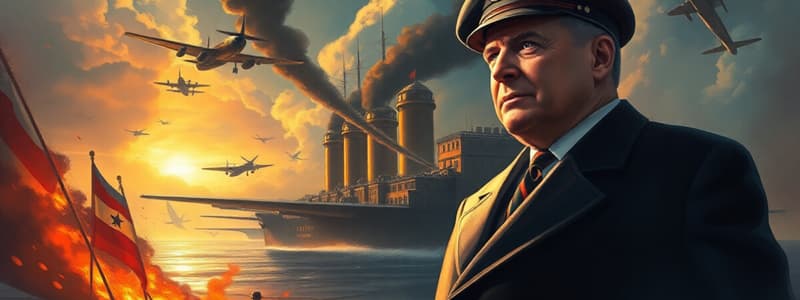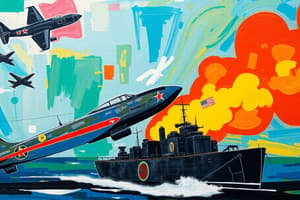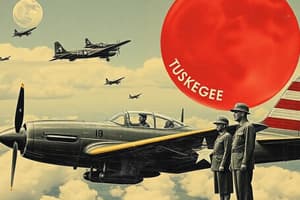Podcast
Questions and Answers
Where did the first wave of Japanese aircraft attack first?
Where did the first wave of Japanese aircraft attack first?
- Ford Island (correct)
- Pearl Harbor
- Hickam Field
- Kaneohe Naval Air Station
What time did the second wave of Japanese aircraft attack Kaneohe Naval Air Station?
What time did the second wave of Japanese aircraft attack Kaneohe Naval Air Station?
- 9:02 A.M.
- 9:05 A.M. (correct)
- 7:53 A.M.
- 8:55 A.M.
What was the time of the initial attack by the first wave of Japanese aircraft?
What was the time of the initial attack by the first wave of Japanese aircraft?
- 7:55 A.M.
- 7:51 A.M. (correct)
- 8:55 A.M.
- 9:02 A.M.
What was the name of the battle that occurred in the content?
What was the name of the battle that occurred in the content?
At what time did the second wave of Japanese aircraft attack Bellows Field?
At what time did the second wave of Japanese aircraft attack Bellows Field?
What was the name of the place where the Japanese aircraft attacked which is marked as "Battleship Row"?
What was the name of the place where the Japanese aircraft attacked which is marked as "Battleship Row"?
Where was the 'Ewa Marine Corps Air Station located?
Where was the 'Ewa Marine Corps Air Station located?
What time did the first wave of Japanese aircraft attack Hickam Field?
What time did the first wave of Japanese aircraft attack Hickam Field?
Which location was NOT attacked by the Japanese aircraft?
Which location was NOT attacked by the Japanese aircraft?
Which locations were attacked by both the first and second waves of Japanese aircraft?
Which locations were attacked by both the first and second waves of Japanese aircraft?
In what month did Hitler launch a massive invasion of the Soviet Union?
In what month did Hitler launch a massive invasion of the Soviet Union?
What pact did Hitler violate when he launched the invasion of the Soviet Union?
What pact did Hitler violate when he launched the invasion of the Soviet Union?
Which of these is NOT a reason for Churchill to support the Soviet Union?
Which of these is NOT a reason for Churchill to support the Soviet Union?
What did Roosevelt do in response to the German submarine threat in the Western Atlantic?
What did Roosevelt do in response to the German submarine threat in the Western Atlantic?
What was the purpose of the Lend-Lease Act?
What was the purpose of the Lend-Lease Act?
Who were the two leaders that met at Newfoundland in 1941 and agreed on the text of the Atlantic Charter?
Who were the two leaders that met at Newfoundland in 1941 and agreed on the text of the Atlantic Charter?
What was the main purpose of the Atlantic Charter?
What was the main purpose of the Atlantic Charter?
According to the map, what was the first target of the Japanese attack on Pearl Harbor?
According to the map, what was the first target of the Japanese attack on Pearl Harbor?
According to the map, Which of these locations was NOT targeted by the Japanese attack?
According to the map, Which of these locations was NOT targeted by the Japanese attack?
What was the time of the second wave of the Japanese attack on Pearl Harbor?
What was the time of the second wave of the Japanese attack on Pearl Harbor?
Which of the following statements best describes the Neutrality Act of 1939?
Which of the following statements best describes the Neutrality Act of 1939?
Why did President Roosevelt call a special session of Congress in the wake of the declaration of war between Britain and France against Germany?
Why did President Roosevelt call a special session of Congress in the wake of the declaration of war between Britain and France against Germany?
What was the main purpose of the destroyers-for-bases deal?
What was the main purpose of the destroyers-for-bases deal?
What event occurred on December 7, 1941, that significantly changed the course of the United States in World War II?
What event occurred on December 7, 1941, that significantly changed the course of the United States in World War II?
What was the main reason for the majority of Americans' belief that Germany posed the greatest danger in the early years of World War II?
What was the main reason for the majority of Americans' belief that Germany posed the greatest danger in the early years of World War II?
How did public opinion influence the passage of the revision of the Neutrality Act of 1939?
How did public opinion influence the passage of the revision of the Neutrality Act of 1939?
What was the price that isolationists demanded in exchange for their support of the revision to the Neutrality Act of 1939?
What was the price that isolationists demanded in exchange for their support of the revision to the Neutrality Act of 1939?
How did the new law passed by Congress, revising the Neutrality Act of 1939, differ from the original act?
How did the new law passed by Congress, revising the Neutrality Act of 1939, differ from the original act?
What was the main challenge for the United States in remaining neutral in the early stages of World War II?
What was the main challenge for the United States in remaining neutral in the early stages of World War II?
What was the primary goal of Roosevelt between August 1939 and December 1941?
What was the primary goal of Roosevelt between August 1939 and December 1941?
Which award was received by Dorie Miller for his bravery during the attack on Pearl Harbor?
Which award was received by Dorie Miller for his bravery during the attack on Pearl Harbor?
How much of Japan's oil supply came from the United States?
How much of Japan's oil supply came from the United States?
What actions did Roosevelt take to apply economic pressure on Japan?
What actions did Roosevelt take to apply economic pressure on Japan?
What was one consequence of Japan’s invasion of China in 1937?
What was one consequence of Japan’s invasion of China in 1937?
What was Roosevelt's main goal in his interactions with Japan leading up to the Pearl Harbor attack?
What was Roosevelt's main goal in his interactions with Japan leading up to the Pearl Harbor attack?
What was a key characteristic of Roosevelt's foreign policy during the early years of World War II?
What was a key characteristic of Roosevelt's foreign policy during the early years of World War II?
Which of these events took place first?
Which of these events took place first?
Why did Roosevelt develop the idea of a hemispheric defense zone?
Why did Roosevelt develop the idea of a hemispheric defense zone?
Which of these actions was NOTtaken by Roosevelt to discourage Japan from attacking the British Empire in the Pacific?
Which of these actions was NOTtaken by Roosevelt to discourage Japan from attacking the British Empire in the Pacific?
Flashcards
Pearl Harbor Attack
Pearl Harbor Attack
The surprise military strike by Japan on December 7, 1941, that led to the U.S. entering WWII.
Medal of Honor
Medal of Honor
The highest military decoration awarded by the U.S. for valor in combat.
Dorie Miller
Dorie Miller
First recognized African American hero of WWII, awarded the Navy Cross for his actions during Pearl Harbor.
Lend-Lease Aid
Lend-Lease Aid
Signup and view all the flashcards
Economic Pressure on Japan
Economic Pressure on Japan
Signup and view all the flashcards
Destroyers-for-Bases Deal
Destroyers-for-Bases Deal
Signup and view all the flashcards
Atlantic Charter
Atlantic Charter
Signup and view all the flashcards
Isolationist Policy
Isolationist Policy
Signup and view all the flashcards
Hemispheric Defense Zone
Hemispheric Defense Zone
Signup and view all the flashcards
Restrictions on Japan
Restrictions on Japan
Signup and view all the flashcards
Neutrality Act of 1939
Neutrality Act of 1939
Signup and view all the flashcards
FDR's support for Britain
FDR's support for Britain
Signup and view all the flashcards
Public opinion
Public opinion
Signup and view all the flashcards
Congressional revision
Congressional revision
Signup and view all the flashcards
Cash-and-carry policy
Cash-and-carry policy
Signup and view all the flashcards
Isolationists
Isolationists
Signup and view all the flashcards
Winston Churchill
Winston Churchill
Signup and view all the flashcards
Nazi-Soviet Pact
Nazi-Soviet Pact
Signup and view all the flashcards
Hitler's Invasion of the Soviet Union
Hitler's Invasion of the Soviet Union
Signup and view all the flashcards
Churchill's Position on Nazism
Churchill's Position on Nazism
Signup and view all the flashcards
Roosevelt and Churchill's Meeting
Roosevelt and Churchill's Meeting
Signup and view all the flashcards
Neutrality of the U.S.
Neutrality of the U.S.
Signup and view all the flashcards
Support for Stalin
Support for Stalin
Signup and view all the flashcards
Ford Island
Ford Island
Signup and view all the flashcards
Naval Air Station
Naval Air Station
Signup and view all the flashcards
First wave of Japanese aircraft
First wave of Japanese aircraft
Signup and view all the flashcards
Second wave of Japanese aircraft
Second wave of Japanese aircraft
Signup and view all the flashcards
Battleship Row
Battleship Row
Signup and view all the flashcards
Time of initial attack
Time of initial attack
Signup and view all the flashcards
Radar site
Radar site
Signup and view all the flashcards
Ewa Marine Corps Air Station
Ewa Marine Corps Air Station
Signup and view all the flashcards
Japanese attack on the U.S.
Japanese attack on the U.S.
Signup and view all the flashcards
Economic advancement in WWII
Economic advancement in WWII
Signup and view all the flashcards
Study Notes
America Enters World War II
- President Roosevelt supported Great Britain, despite official neutrality.
- A "destroyers-for-bases" deal was made with Britain.
- The Lend-Lease Act was passed, allowing the US to supply war materials to Britain.
- The US established a hemispheric defense zone in the Atlantic.
- The US imposed economic sanctions on Japan, restricting trade.
- Japan's attack on Pearl Harbor (December 7, 1941) prompted a US declaration of war.
- The attack involved a surprise attack by Japanese forces on the US Pacific Fleet.
- The attack led to thousands of American casualties and significant US involvement in WWII.
Isolationist Debate
- Americans debated whether to remain neutral or aid Allied nations.
- The America First Committee advocated for US isolationism.
- President Roosevelt was elected to a third term amid the debate.
- Widespread public acceptance of the destroyers-for-bases deal signaled a shift in American opinion.
Events Leading to US Involvement
- The Neutrality Act of 1939 allowed sales of arms to warring nations on a "cash-and-carry" basis.
- The Destroyer-for-Bases deal allowed the US to transfer destroyers to Britain in exchange for US bases on British territory.
- Congress passed the Lend-Lease Act, empowering the US to supply arms to the allies.
- Japan's expansion in Asia and aggressive actions against other countries led to US restrictions on exports.
- The Atlantic Charter was issued by Roosevelt and Churchill outlining the vision of postwar world and principles.
Political Cartoons and Analysis
- Political cartoons were used to reflect and shape public opinion on the war.
- Political cartoons often depicted the conflict and how it was perceived.
Lend-Lease Act
- The Lend-Lease Act allowed the US to provide military aid to countries fighting against the Axis powers.
- It lent or leased war materials in exchange for repayment at a later date.
- The act was crucial for supporting Great Britain and other allied nations in the early stages of the war.
Pearl Harbor
- Pearl Harbor is a naval base in Hawaii.
- Japan attacked the US fleet at Pearl Harbor on December 7, 1941.
- The attack was a surprise, leading to significant damage to the US fleet.
- The attack on Pearl Harbor was followed by a US declaration of war against Japan.
Studying That Suits You
Use AI to generate personalized quizzes and flashcards to suit your learning preferences.




